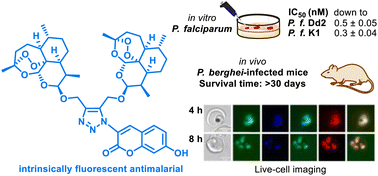Autofluorescent antimalarials by hybridization of artemisinin and coumarin: in vitro/in vivo studies and live-cell imaging†
Abstract
Malaria is one of our planet's most widespread and deadliest diseases, and there is an ever-consistent need for new and improved pharmaceuticals. Natural products have been an essential source of hit and lead compounds for drug discovery. Antimalarial drug artemisinin (ART), a highly effective natural product, is an enantiopure sesquiterpene lactone and occurs in Artemisia annua L. The development of improved antimalarial drugs, which are highly potent and at the same time inherently fluorescent is particularly favorable and highly desirable since they can be used for live-cell imaging, avoiding the requirement of the drug's linkage to an external fluorescent label. Herein, we present the first antimalarial autofluorescent artemisinin-coumarin hybrids with high fluorescence quantum yields of up to 0.94 and exhibiting excellent activity in vitro against CQ-resistant and multidrug-resistant P. falciparum strains (IC50 (Dd2) down to 0.5 nM; IC50 (K1) down to 0.3 nM) compared to reference drugs CQ (IC50 (Dd2) 165.3 nM; IC50 (K1) 302.8 nM) and artemisinin (IC50 (Dd2) 11.3 nM; IC50 (K1) 5.4 nM). Furthermore, a clear correlation between in vitro potency and in vivo efficacy of antimalarial autofluorescent hybrids was demonstrated. Moreover, deliberately designed autofluorescent artemisinin-coumarin hybrids, were not only able to overcome drug resistance, they were also of high value in investigating their mode of action via time-dependent imaging resolution in living P. falciparum-infected red blood cells.

- This article is part of the themed collection: 2023 Chemical Science Covers


 Please wait while we load your content...
Please wait while we load your content...